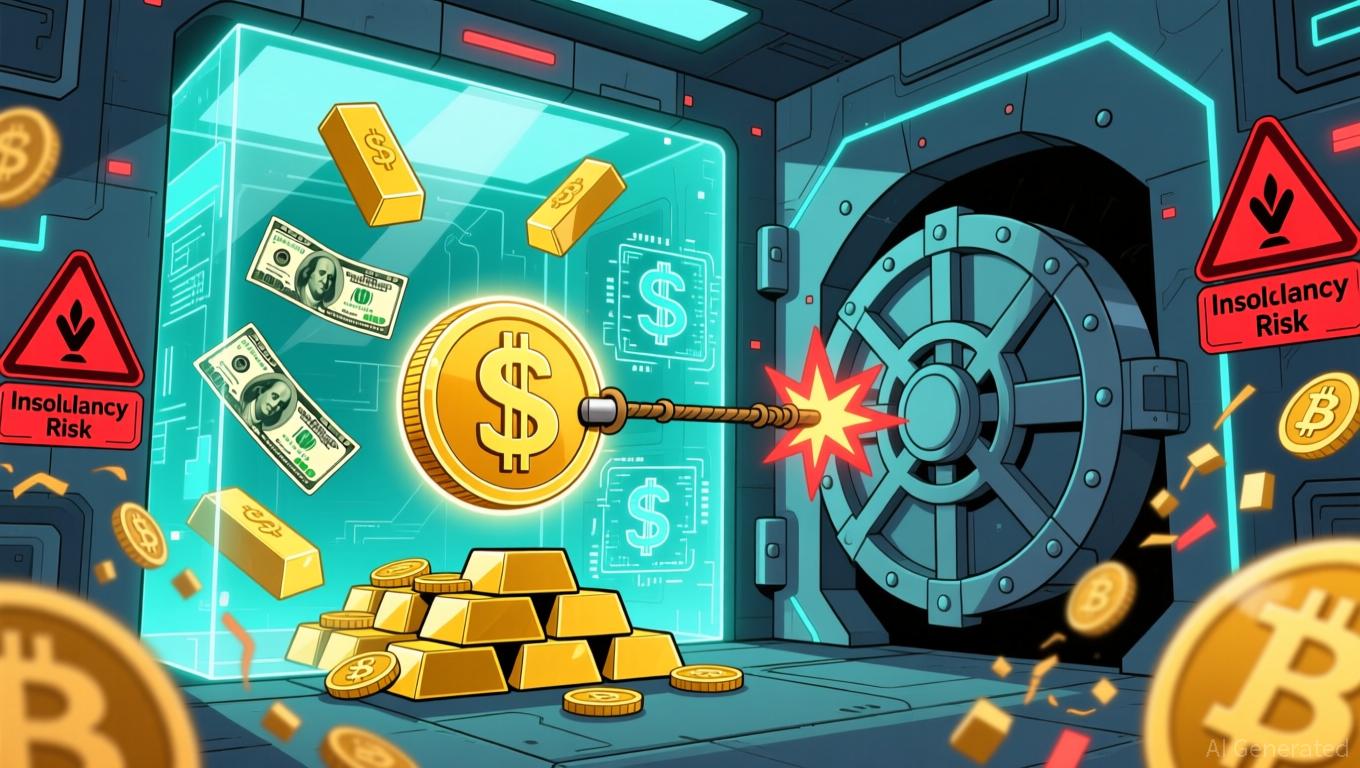Bitcoin News Update: S&P Rating Drop Highlights Tether’s Risky Asset Holdings and Lack of Transparency
- S&P downgrades Tether's USDT to "5 (weak)" due to high-risk reserves and transparency gaps. - Tether's 5.6% BTC exposure exceeds overcollateralization margins, risking undercollateralization if prices drop. - CEO dismisses critique as traditional finance bias, claiming no "toxic" assets in reserves. - Regulators intensify scrutiny as stablecoin centralization risks emerge amid $184B USDT circulation. - S&P urges Tether to reduce risky assets and enhance reserve disclosure to rebuild trust.
S&P Global Lowers Tether’s USDT Rating to Weakest Level
S&P Global Ratings has assigned Tether’s USDT stablecoin its lowest possible rating—“5 (weak)”—on the agency’s 1–5 risk scale for stablecoins. This decision was driven by concerns over Tether’s growing allocation to riskier assets and ongoing issues with transparency. The downgrade highlights increasing regulatory attention on stablecoins, which are intended to maintain a consistent value by being pegged to fiat currencies such as the U.S. dollar.
As the issuer of USDT, Tether now faces mounting scrutiny regarding the makeup of its reserves and its disclosure practices, especially as regulatory expectations continue to evolve.
Concerns Over Reserve Composition
S&P’s downgrade reflects its view that Tether’s reserves now include a larger share of volatile assets like Bitcoin (BTC), gold, corporate bonds, and secured loans. These assets introduce additional credit, market, and liquidity risks. S&P specifically noted that Bitcoin now represents 5.6% of USDT’s backing, which surpasses the 3.9% overcollateralization margin. This means that if Bitcoin’s price were to fall further, Tether’s reserves might not be sufficient to fully cover USDT in circulation, raising the risk of undercollateralization.
Additionally, S&P criticized Tether for providing limited information about its custodians, counterparties, and how its reserves are managed. The agency also pointed out that Tether’s reserves are not separated in a way that would protect users if the company became insolvent.

Tether’s Response to the Downgrade
Paolo Ardoino, Tether’s CEO, responded strongly to S&P’s decision, dismissing the downgrade as evidence of traditional finance’s resistance to disruptive companies. In a statement on X, Ardoino argued that Tether is “the first overcapitalized firm in the financial industry” and insisted that its reserves do not contain any “toxic” assets. He also criticized S&P for using outdated assessment methods designed for banks rather than digital asset companies, emphasizing that Tether operates outside of conventional financial systems.
Ongoing Debate Over Transparency and Risk
This dispute has brought to light the ongoing friction between stablecoin issuers and regulators regarding transparency and risk management. Tether claims that its $184 billion in USDT is fully backed by reserves, including 116 tons of physical gold. However, S&P pointed out that the details of these assets remain unclear. Even with significant holdings in short-term U.S. Treasuries, the lack of detailed information about counterparties and reserve management undermines confidence in USDT’s stability. These concerns have fueled broader questions about the risks of centralization in stablecoins, which depend on trust in the issuer’s financial practices and governance.
Market Context and Future Outlook
The downgrade comes at a time when Bitcoin is experiencing its steepest monthly decline since 2022, contributing to volatility across the cryptocurrency market. Despite this, CoinGecko reports that USDT’s supply increased by $1 billion in November, reaching $184.4 billion. This contrast between market growth and governance concerns underscores USDT’s importance as a liquidity provider in crypto markets, even as its operational model faces greater scrutiny.
As regulators around the world push for clearer rules, the debate over the risks of stablecoin centralization is expected to intensify. S&P has suggested that Tether could improve its rating by reducing its exposure to high-risk assets and providing more detailed disclosures about its reserves and counterparties. For now, the downgrade serves as a reminder to all stablecoin issuers that transparency and robust risk management are essential for maintaining trust in the sector.
Disclaimer: The content of this article solely reflects the author's opinion and does not represent the platform in any capacity. This article is not intended to serve as a reference for making investment decisions.
You may also like
COAI Experiences Steep Price Drop: Opportunity for Contrarian Investors or Red Flag for Junior Gold Mining Stocks?
- COAI refers to both ChainOpera AI and junior gold miners' index, with this analysis focusing on the latter's market dynamics. - Junior gold miners (GDXJ ETF) fell 27% in six months amid dollar strength, inflation fears, and overbought conditions after a 128.8% rally. - Technical indicators show bearish signals: broken trend channels, negative volume balance, and RSI divergence, though long-term bull trends persist. - GDXJ's 163.9% surge outpaced gold bullion gains, creating valuation gaps, while ChainOpe

Silver Soars Amid Ideal Conditions of Policy Shifts and Tightening Supply
- Silver surged to $52.37/oz as Fed rate cut expectations (80% probability) and falling U.S. Treasury yields boosted demand for non-yielding assets. - China's record 660-ton silver exports and 2015-low Shanghai warehouse inventories intensified global supply constraints, pushing the market into backwardation. - Geopolitical risks (Ukraine war) and potential U.S. silver tariffs added volatility, while improved U.S.-China relations eased short-term trade concerns. - Prices face critical $52.50 resistance; Fe
XRP News Today: As XRP Declines, Retail Investors Turn to GeeFi's Practical Uses
- GeeFi's presale hits 80% of Phase 1 goal with $350K raised, targeting 3,900% price growth as XRP declines 20% monthly. - GEE's utility-driven features like crypto cards, multi-chain support, and 55% staking returns contrast with XRP's institutional dependency and shrinking retail base. - Deflationary tokenomics and 5% referral bonuses drive FOMO, positioning GeeFi as a 2026 crypto disruptor amid XRP's regulatory and adoption challenges.

Sloppy implementation derails MegaETH's billion-dollar stablecoin aspirations
- MegaETH abandoned its $1B USDm stablecoin pre-deposit plan after technical failures disrupted the launch, freezing deposits at $500M and issuing refunds. - A misconfigured Safe multisig transaction allowed early deposits, causing $400M inflows before the team scrapped the target, citing "sloppy execution" and operational misalignment. - Critics highlighted governance flaws, uneven access (79 wallets >$1M vs. 2,643 <$5K deposits), and 259 duplicate addresses, raising concerns about transparency and bot ac
